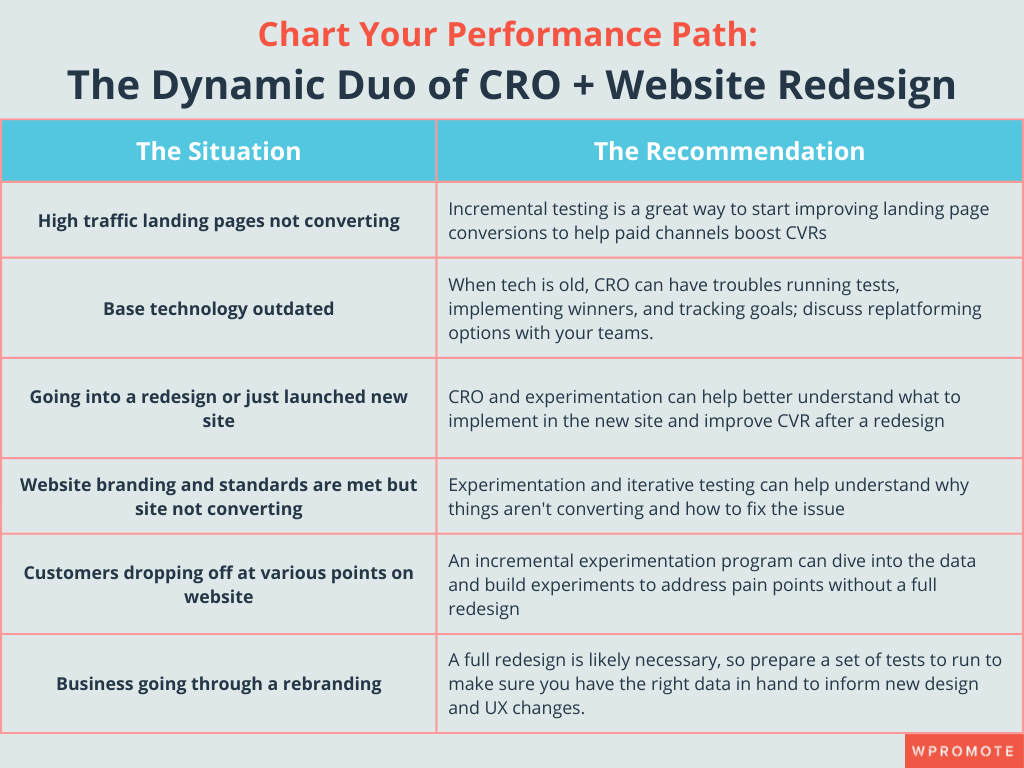Many organizations make a fundamental mistake about the way they deal with their single biggest digital performance driver: their website. They either rely on periodic site redesigns to keep their site in shape or continuous tweaks based on whatever they need right now.
Big mistake. Huge.
Conversion rate optimization (CRO), a process of continuously testing elements of your site to ensure the best possible performance, and large-scale website redesigns need to work together. It’s not an either/or choice; both are essential if you want to wring the most value out of your site.
Think of a site redesign as an opportunity to consider holistically how everything about your site is working together (and working in tandem with your campaigns on other channels): UX, design, messaging, architecture, frontend, backend. CRO is how you can get the most out of specific performance levers and really supercharge your results. If your site is a race car, CRO is how you wring every possible extra MPH out of the engine you designed.
How a strong CRO strategy unlocks shortcuts to a successful website redesign
Redesigns are a necessary part of having a website, and often involve deeper conversations into brand positioning or full brand marketing campaigns. They might include adding new technical elements, updating some of the backend of the site, creative and messaging changes to the brand itself, fundamental reorganizations of the site navigation, and more.
Everyone knows that involves a fair amount of stress: some drops in performance are a necessary evil when it comes to launching a redesign and/or migrating to a new instance of your site.
Your CRO program should be/can help you maintain performance through a redesign and mitigate some of the immediate effects of large-scale changes.
CRO can also provide essential data to your dev and design teams about what works and which elements are most important to the site, taking some of the burden off the marketing and design teams to “get it right” out the gate.
But the value of a strong CRO program really comes to life in between redesigns, when continuous improvement and strategic optimization turns up the volume on what your site can deliver.

Think about it this way: if you’re selling a house you bought a few years ago without ever making any improvements or updates, you’re unlikely to get the maximum possible return (see: every show on HGTV). But if you made smart updates over the years in the areas that are most likely to attract and drive value for a new buyer or invest in modern finishes, chances are you’d see a bigger return on your investment.
CRO is your investment in regular maintenance and strategic updates; the redesign is the big sell. That’s why a partnership between a website redesign and CRO is such a game changer. Together, they help make sure that you get things right in the first place.
Why CRO will save you money in a redesign while maximizing potential returns
Almost all sites that go through a traditional website redesign see dips in traffic and conversion rates, the former because search engines need time to get a handle on the changes, the latter because customers aren’t familiar with the new site and can find changes jarring or confusing.
But there’s another reason the new version of your site might be operating less efficiently: critical parts of your site that drive performance often get moved or changed in ways that make the site less effective when you update the backend or frontend.
CRO can actually help you get in front of some of those potential challenges. As brand, dev, design, SEO, and content teams consider big, holistic questions about what a major overhaul needs to accomplish, you can start testing incremental changes to the biggest performance-driving parts of your site to understand what you should and shouldn’t change in order to mitigate some of the immediate post-redesign issues.
Site launches are generally both work-intensive and expensive, as well as risky. CRO can lower some of that cost on both fronts in a lower risk environment.
Once you launch a new site, you should generally give it a month or so to stabilize before trying to fix a bunch of little elements; it’s not always clear what can be attributed to expected fluctuations based on the changes and what’s actually broken. But advanced CRO testing should help make that period less painful and help you pinpoint what’s not working.
And once the site is live, you can keep systematically testing against different elements, from reverting to previous, higher-performing versions of particular areas of the site to introducing new potential conversion paths. Think of CRO as the bread on either side of your redesign sandwich: it should be happening on either side.

Source: Decibel
Remember to define the role CRO is playing; it’s not a critique of design or dev, it’s the means to make their contributions make the biggest possible impact by providing additional insights and information and ensuring their work will continue to deliver value over time.
CRO delivers essential, data-backed information about updates that should/should not be made on site to inform the redesign process. After launch, CRO can be used to mitigate conversion rate decreases and get performance back on track faster.
To redesign or not to redesign: when to embark on a full scale site redesign vs. continuous CRO marketing
Digital marketing is always changing: new technology, new features, new customer expectations, new branding or positioning, privacy restrictions, UX best practices. But every organization is different when it comes to how frequently a site should go through a redesign.
In the past, a good rule of thumb for a redesign was every five years. But according to research by Andy Crestodina over at Orbit Media, the average lifespan of a website now is about 2 years and 7 months. Plenty of sites need bigger updates much more frequently. If your site is being held together by duct tape and patches, it’s a good sign that your site is ready for the full treatment.
But the best way to tell if it’s time for a redesign is to ask your customers. They should be your source of truth and will often be brutally honest about what they would change to make their experience better. And we are in the age of the two-way conversation with customers. Reach out to them, offer surveys on your site, and find a way to get their input without feeling intrusive.
In lieu of actual customer feedback, you can recruit people at your organization (that can include you!) to explore the site or take a series of actions. Encourage them to remove all business bias and come into the experience as a potential customer who isn’t necessarily familiar with your brand, your site, or how they can purchase something or sign up. Then get their honest assessment.
Where you focus your efforts largely depends on what goals your site is built to achieve. But every site should feel cohesive and intuitive to an unfamiliar user even as it drives them toward your desired action or outcome, so start with any areas that show signs of friction, especially if they’re closer to the conversion point: if your ecommerce site is showing a high drop-off from product page to cart, for example, focus on that first.
It should be pretty clear whether or not a top-to-bottom site redesign is necessary or whether a specific touchpoint isn’t performing to its fullest potential.

The thing about CRO is that it’s never done, just like any optimization in digital marketing. Customer behavior and expectations are always changing, so any business that is interested in increasing revenue and conversions should always be testing, even if you have a redesign coming soon or just went through one.
Don’t look at CRO as a one-time expense or a limited-time investment. You’re leaving money on the table when you aren’t employing a rigorous test-and-learn approach to your site.







Responses